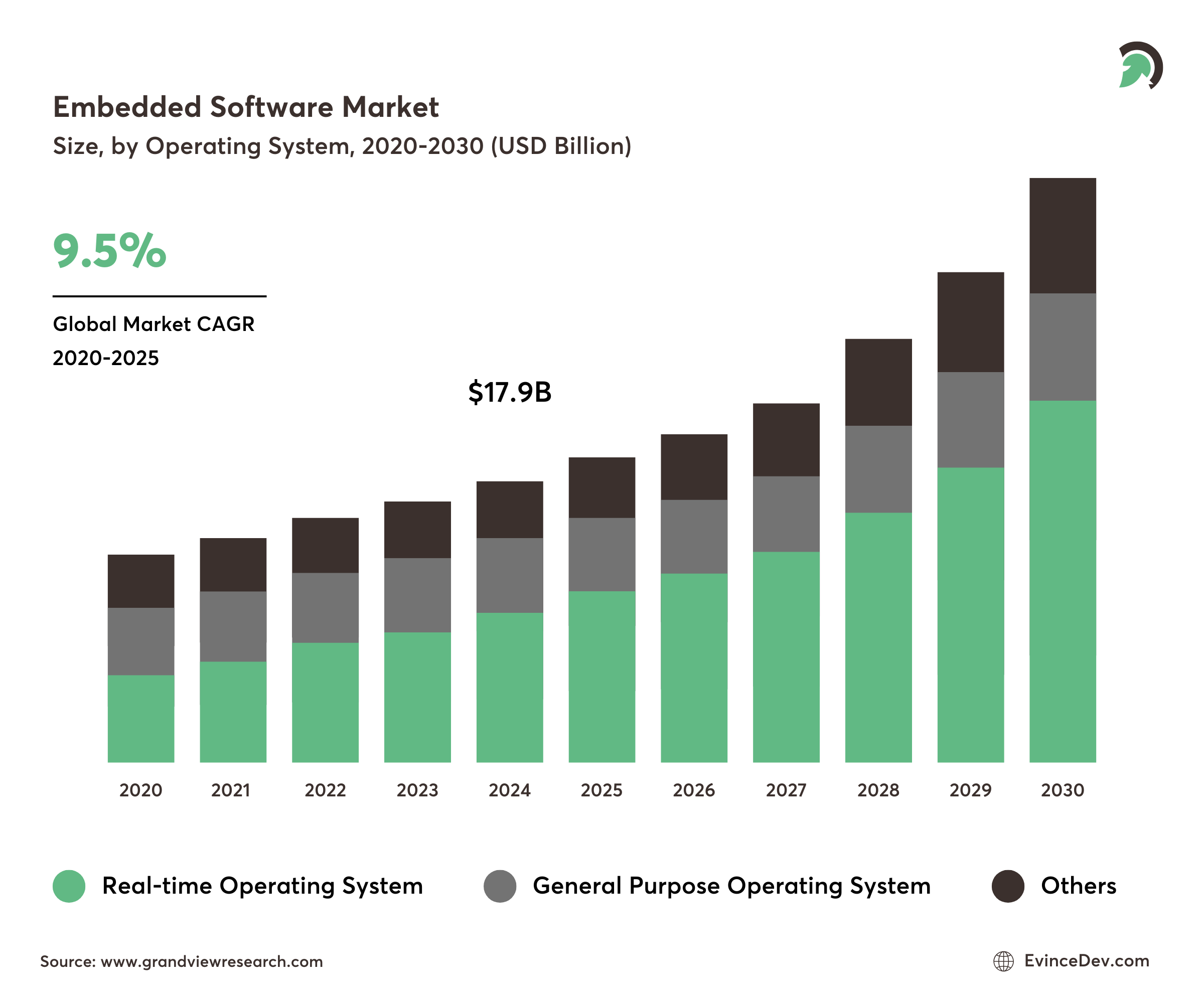Embedded software development plays a crucial role in today’s world, powering devices from smartphones to industrial machines. It is a specialized form of software development that involves creating software specifically designed to operate hardware with real-time requirements, low power consumption, and minimal memory usage. In an increasingly connected world, embedded systems are the backbone of Internet of Things (IoT) devices, automotive applications, medical devices, and more. As technology continues to advance, software development is becoming more critical for businesses that want to stay competitive and efficient.
Valued at $17.91 billion in 2024, the global embedded software market is set to grow consistently, showing a 9.5% annual growth rate until 2030.

What is Embedded Software Development?
Embedded software development refers to the process of creating software that runs on dedicated hardware devices. Unlike traditional software that runs on general-purpose computers, embedded software operates on embedded systems, which are designed to perform specific tasks with limited resources. These systems are an integral part of consumer electronics like smartphones, washing machines, automobiles, and even complex medical devices.
Primary challenge in embedded software development is ensuring the software works seamlessly with hardware while meeting specific performance, size, and power constraints. Developers often use specialized programming languages, tools, and techniques to write efficient code for these systems. Unlike desktop or mobile applications, embedded software is often hardwired to the device’s hardware and designed for real-time operations.
Why is Embedded Software Important?
Embedded software is foundational to many industries today, driving innovation and creating smarter, more efficient systems. One of the core reasons why embedded software development is so crucial is the increasing demand for connected devices and automation. Industries like healthcare, automotive, and IoT rely heavily on embedded software to deliver reliable performance and user-friendly interfaces.
In healthcare, for example, embedded software controls medical devices like pacemakers, insulin pumps, and diagnostic machines. In the automotive industry, embedded systems enable features like autonomous driving, engine control, and infotainment systems. Additionally, in the IoT space, devices such as smart thermostats, home security systems, and wearable devices rely on embedded software to function effectively and safely.
Key Features and Components of Embedded Software
Embedded software development requires a deep understanding of both hardware and software. The key components of embedded systems include:
- Microcontrollers/Processors: The core processing unit that executes instructions.
- Operating Systems: Some embedded systems run on specialized operating systems like FreeRTOS, while others function without one, utilizing bare-metal programming.
- Sensors and Actuators: These enable the device to interact with the external environment.
- Communication Protocols: These allow embedded devices to connect with other devices, typically through protocols such as Bluetooth, Wi-Fi, or Zigbee.

Effective embedded software development also requires attention to real-time capabilities, memory management, and power efficiency. These systems must perform their tasks with high reliability, especially in mission-critical applications.
Challenges in Embedded Software Development
Despite the many advantages, embedded software development presents several challenges:
- Real-time Constraints: Embedded systems often operate in real-time environments, meaning they must respond to inputs or data processing within a set time limit. Failure to meet these deadlines can lead to system failures or malfunctions.
- Memory and Power Constraints: Embedded devices usually have limited memory and processing power. Developers need to optimize their software to make the best use of these resources without sacrificing functionality.
- Hardware-Software Integration: One of the most significant hurdles is ensuring that the embedded software is compatible with the hardware. This requires precise and tailored development processes to ensure seamless integration.
- Security and Reliability: Given the critical nature of embedded systems, especially in healthcare, automotive, and industrial applications, ensuring security and reliability is paramount. Developers need to implement rigorous testing and validation processes to ensure the software functions securely.
Embedded Software Development Process
The embedded software development process generally follows these key stages:
- Requirement Gathering: Understanding the functional and non-functional requirements of the embedded system, including performance, reliability, and real-time constraints.
- Design & Architecture: Creating the software architecture and designing components like data structures, algorithms, and communication protocols.
- Coding: Writing the code using programming languages like C, C++, or Python. Tools such as embedded compilers and debuggers are used for this phase.
- Testing & Debugging: Testing the software on hardware and conducting various tests like unit tests, integration tests, and performance tests.
- Deployment: Once the software has passed testing, it is deployed to the embedded system, and any necessary updates are made.
- Maintenance & Support: Ongoing support and maintenance to ensure that the system continues to operate efficiently, with periodic updates as needed.

Best Practices for Successful Embedded Software Development
To achieve the best results in embedded software development, here are some best practices:
- Modular Design: Breaking the system into smaller, manageable parts helps with testing and debugging.
- Efficient Code: Given the limited resources of embedded systems, writing memory-efficient and high-performance code is essential.
- Automated Testing: Employing automated testing tools to verify system performance and reliability can save time and reduce errors.
- Security Measures: Implementing strong security measures like data encryption and secure boot processes is essential, particularly for IoT and medical devices.
- Documentation: Proper documentation helps ensure that the software is maintainable and understandable by different teams, especially when scaling the project.
Embedded Software Development Process
Emerging Trends in Embedded Software Development
- IoT Integration: As the world becomes more connected, IoT-driven embedded systems are in high demand. Embedded software is the key enabler for devices that interact with other smart devices and networks.
- Artificial Intelligence: AI and machine learning are becoming increasingly integrated into embedded systems, enabling devices to make decisions and learn from their environment.
- Edge Computing: With the rise of edge computing, embedded systems are becoming more capable of processing data locally, reducing latency and bandwidth issues.
- 5G Connectivity: The upcoming 5G revolution will push the limits of embedded software by requiring more advanced, high-performance systems capable of handling real-time data streaming.
Achieving Success in Embedded Software Development
At EvinceDev, we understand that embedded software development is critical in shaping the future of industries seeking smarter, more connected devices. Whether you’re building an IoT device, medical instrument, or a smart car feature, the success of your product hinges on the quality and performance of its embedded software.
By adhering to best practices, embracing emerging technologies, and prioritizing security, we help businesses leverage embedded software development to innovate and stay competitive in an ever-evolving market. Get in touch with EvinceDev today for a free consultation and discover how we can drive your embedded software development success.




